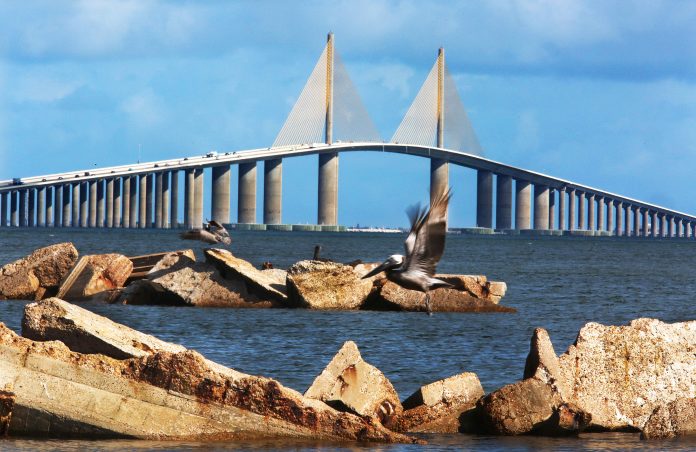As the strongest cold front in many months arrived in the Tampa Bay region, anglers fishing the best methods & most appropriate species for weather conditions continued to have good success at the Sunshine Skyway Fishing Piers. King mackerel angling at the piers remains a hot topic as yet another monster king was taken this week and kings will often be triggered to feed aggressively during passing cold fronts. Gag grouper were on the chew with the front approaching and gags are yet another species that can be energized by cooler water temperatures. Spanish mackerel went nuts on Friday as the front approached and many anglers reported easy limits of fish within only a short time frame. Jack crevalle were prevalent this past week and many folks visiting for just sightseeing were amazed at the raw aggression of this species. Finally, lots of anglers reported spotting cobia surfing the waves as winds began to pick-up, a common occurrence at the mouth of Tampa Bay during passing cold fronts.
A new week saw yet another monstrous king mackerel hitting the pavement at the South Pier. Many nearby anglers reported the fish to be almost 5 feet in length with a healthy girth, likely placing it near (or even exceeding) the 50 lb. size class. The presence of these huge solitary kingfish entering the bay somewhat late in a typical run is not uncommon, and a later run (like this season) could see some big kings around all month long. Your author would never claim to be a kingfish expert, but instead simply has the advantage of collecting data through reports of catches & conditions over a long period of time. Almost every fall, the largest kings are taken as singles and very near the end of the time when folks are still targeting these fish. The same data holds true late in the spring run, but the largest fish at the piers each season seem to be fall fish. Kingfish will feed on nearly any larger baitfish, so do not assume you need a blue runner or large herring to be in the game. Pinfish have taken plenty of large kings at the piers and were the baits reportedly used on the last few very big fish taken. As these late fall monsters are almost always cruising alone, position baits at various parts of the water column using a trolley-rod system to increase the odds of one of these rogues coming into contact with your bait.
Gag grouper were also feeding with reckless abandon and many keeper gags have been taken over the past several weeks. Pier staffer and avid grouper angler Tony Silapheth was using multiple methods to target gags this past week. Silapheth does not tie himself to one tactic and uses everything from diving plugs to anchored live baits. The multi-tiered approach makes plenty of sense because both fish aggression levels and their location on a piece of structure can be varied not only day-to-day, but even hour-to-hour with changing tidal & water conditions. Perhaps a plug will take the most aggressive fish, a free-lined bait trigger a neutral fish and an anchored bait entice a fish in a negative feeding mode. The fact remains that a change-up can often mean producing a keeper gag versus only catching several shorts. The nice thing this season is that Skyway Pier anglers have the entire month of December to target gags at one of the finest land-based grouper fisheries in America.
Spanish mackerel caught fire just ahead of the passing cold front and many anglers took limits of fish by casting Gotcha lures, spoons and jigs to these aggressively feeding fish. The wind and waves of the approaching front were already creating some areas where stained water met clear water, and anglers finding the clearest water had the most success. Clear versus stained water lines can occur on many sections of the piers because tidal flushes from various parts of the bay can vary greatly in the sediments they might carry. Mackerel do not prefer highly stained water, but they certainly will hunt the lines that these situations often create. Another tip to keep in mind when pursuing Spanish mackerel during frontal and post-frontal conditions is that baitfish will sometimes be driven to deeper water and hold near the bottom for several days. The mackerel are often right there with them, but slower methods of jigging or slow-rolling other artificial lures will far out produce the more traditional speedy retrieves.
Visitors to the Skyway Piers got a great glimpse of the food chain in operation as jack crevalle boiled the waters at the mouth of Tampa Bay. Jacks in the 3 lb. to 8 lb. range ripped through schools of baitfish and even handed anglers some broken lines & tackle. Fish were most prevalent along the approach sections of the piers, but some were reported along the entire span. Anglers used a variety of methods, ranging all the way from rapid jigging to slowly pulling live baits through the water column. Live bait was unnecessary when the most ravenous schools came through, but it did seem to provide anglers with a few extra fish from time to time that might have gotten separated from their schooling brethren. Jacks have a darker flesh and a pronounced lateral line, but are just fine for many methods of fish cookery, especially if bled upon catching and pending the removal of the lateral line. Indeed, many folks prefer these fish for soups & chowders that involve a wide variety of very flavorful seasonings and ingredients.
- The Skyway, Paul Bristow - August 24, 2018
- The Skyway, Paul Bristow - August 17, 2018
- The Skyway, Paul Bristow - August 10, 2018










